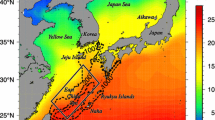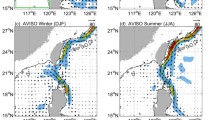Abstract
The Kuroshio flows north along the east coasts of the Philippines and Taiwan. Between these two land masses lies the Luzon Strait which connects the Pacific Ocean to the South China Sea. The Kuroshio usually flows north past this strait, but at times part or all of it flows west through the strait into the South China Sea forming a loop current. It has been suggested that the loop current forms when the northeast monsoon deflects the Kuroshio through the Luzon Strait. In this study, satellite-derived sea-surface temperature images are used to observe the Kuroshio in the Luzon Strait region. Together with wind data from the region, these observations indicate a loop-current development process which is largely determined by an integrated supercritical wind stress parameter. The loop current grows when a four-day average of the local wind-stress component directed to the south exceeds 0.08 Nm−2. When this average wind-stress component drops below the critical value, the Kuroshio returns to its northward path.
Similar content being viewed by others
References
Adamec, D. and R. Elsberry (1985): Response of an intense oceanic current system to cross-stream cooling events.J. Phys. Oceanogr.,15, 273–287.
Cayula, J.-F. (1993): Automatic front detection using a sequence of sea surface temperature images. Ph.D. Thesis, University of Rhode Island, Narragansett, RI.
Chu, T.-Y. (1972): A study on the water exchange between Pacific Ocean and the South China Sea.Acta Oceanographica Taiwanica,2, 11–24.
Fan, K.-L. (1982): A study of water masses in Taiwan Strait.Acta Oceanographica Taiwanica,13, 140–153.
Fanning, A., R. Greatbatch, A. D. Silva and S. Levitus (1994): Model-calculated seasonal transport variations through the Florida straits: A comparison using different wind-stress climatologies.J. Phys. Oceanogr.,24, 30–45.
Farris, A. (1995): Effects of wind on the Kuroshio in the Luzon Strait. Master's Thesis, University of Rhode Island, Kingston, Rhode Island.
Guo, Z. and F. Wendong (1988): The Kuroshio in Luzon Strait and its transport during September 1985.Tropic Oceanology,2, 13–19.
Huang, Y. (1988): Temperature and salinity distributions in the South China Sea and adjacent waters.Prog. Oceanogr.,21, 493–501.
Nitani, H. (1972): Beginning of the Kuroshio. p. 129–163. InKuroshio, University of Washington Press, Seattle, WA.
Shaw, P.-T. (1991): The seasonal variation of the intrusion of the Philippine Sea water into the South China Sea.J. Geophys. Res.,96, 821–827.
Shaw, P.-T. and S.-Y. Chao (1994): Surface circulation in the South China Sea.Deep-Sea Res.,41, 1663–1683.
Stramma, L., P. Cornillon, R. A. Weller, J. F. Price and M. G. Briscoe (1986): Large diurnal sea surface temperature variability: Satellite and in situ measurements.J. Phys. Oceanogr.,16, 827–837.
Su, J., B. Guan and J. Jiang (1990): The Kuroshio. Part I. Physical features.Oceanography and Marine Biology Annual Review,28, 11–71.
Uda, M. and T. Nakao (1973): Water masses and currents in the South China Sea and their seasonal changes. p. 161–188. InThe Kuroshio III, Mongkol Karnpim Press and Publishing, Bangkok.
Vazquez, J., A. Tran, R. Sumagaysa, E. Smith and M. Hamilton (1995): NOAA/NASA Pathfinder AVHRR Oceans sea-surface temperature data set user's guide. Technical report, Jet Propulsion Laboratory, California Institute of Technology.
Wang, J. and C.-S. Chern (1987a): The warm-core eddy in the northern South China Sea, I. Preliminary observations on the warm-core eddy.Acta Oceanographica Taiwanica,18, 92–103.
Wang, J. and C.-S. Chern (1987b): The warm core eddy in the northern South China Sea, II. A simple mechanism for the establishment and development of the warm-core eddy.Acta Oceanographica Taiwanica,18, 104–113.
Wang, J. and C.-S. Chern (1988): On the Kuroshio branch in the Taiwan Strait during wintertime.Prog. Oceanogr.,21, 469–491.
Wu, J. (1982): Wind stress coefficients over sea surface from breeze to hurricane.J. Geophys. Res.,87, 9704–9706.
Xue, H., J. Bane and L. Goodman (1995): Modification of the Gulf Stream through strong air-sea interactions in winter: Observations and numerical simulations.J. Phys. Oceanogr.,25, 533–557.
Author information
Authors and Affiliations
Rights and permissions
About this article
Cite this article
Farris, A., Wimbush, M. Wind-induced Kuroshio intrusion into the South China Sea. J Oceanogr 52, 771–784 (1996). https://doi.org/10.1007/BF02239465
Received:
Revised:
Accepted:
Issue Date:
DOI: https://doi.org/10.1007/BF02239465




